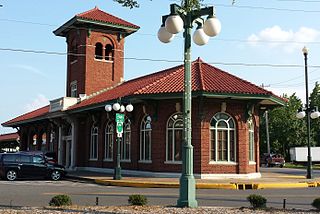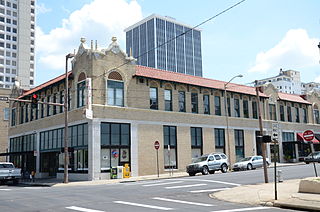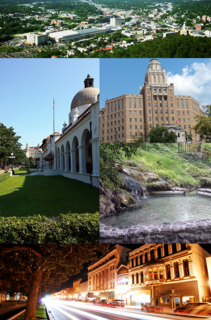
Butchie's Drive-In, now known as Bailey's Dairy Treat, is a historic restaurant at 534 Park Avenue in Hot Springs, Arkansas. It is a small single-story Art Moderne structure, with sleek rounded lines, neon lighting, and a stucco finish. There are two service windows at the front, and the interior has retained much of its original form, even though the kitchen equipment has been upgraded. The floor is largely original quarry tile, and the bathroom has original fixtures. Built in 1952, this is one of the few establishments of this type to survive, of a number that once lined Park Avenue.

The Fullerton Odd Fellows Temple, also known as IOOF Building or Independent Order of Odd Fellows Lodge No.103 or Williams Building, is located in Fullerton, Orange County, California. It was built during 1927-28 for the Independent Order of Odd Fellows Lodge Number 103, which existed from 1901 to 1981.

The Weiss Center, formerly the U.S. Post Office-Manchester Main is a historic building at 491 Main Street in Manchester, Connecticut. It was built in 1931 and was listed on the National Register of Historic Places in 1986 for its architecture. It includes Colonial Revival, Classical Revival, and Georgian Revival architectural features.

The First National Bank of Morrilton is a historic commercial building at Broadway and Moose Streets in Morrilton, Arkansas. It is a narrow five-story masonry building, occupying a prominent location at the city's main downtown intersection. It was built in 1925 to a design by architect Charles L. Thompson, and has Classical Revival and Bungalow/Craftsman features. The short Broadway Street facade features a recessed entrance with Classical features, while the upper floors are relatively unadorned red brick, with Craftsman motifs in tile around the top floor windows.

The Standard Ice Company Building is a historic commercial building at 517 South Main Street in downtown Stuttgart, Arkansas. Constructed in 1926, the building is of the Spanish Revival style, with a tile roof and glazed brick façade. The company manufactured blocks of ice for commercial and residential use, and remained in business until 1978. As household refrigerators became widespread, the facility was used to freeze and pack strawberries, as well as process and freeze ducks killed by local hunters.

The Modern News Building is a historic commercial building at 216 North Main Street in downtown Harrisburg, Arkansas. It is a single-story rectangular brick building, with a flat roof and simple styling. A tall front steps down toward the rear of the building, with the side walls capped in tile. The facade is three bays wide, with a center entry flanked by recessed windows. A metal awning extends across the facade. The building was built in 1888, and is significant as the home of The Modern News, which has been Harrisburg's newspaper since that year.

The Monroe County Courthouse is located at Courthouse Square in Clarendon, the county seat of Monroe County, Arkansas. It is a large brick building with Classical Revival features, designed by the architect Charles L. Thompson and built in 1911. It has low octagonal towers topped by tile roofs at each corner, and a tall clocktower on its main facade. The interior lobby spaces are finished with ceramic tile floors and marble wainscoting.

The Citizens Building is a historic commercial building at 723 Central Avenue in Hot Springs, Arkansas. It is a narrow six-story steel and masonry structure, built in 1911-12. It was the first skyscraper to be built in Hot Springs, and was immediately noted for its dignified exterior. The first floor consists of a colonnade of stone arches, above which four identical floors rise, finished in white glazed brick manufactured by the Leon Tiffany Company. The top floor is set off from the lower floors by a band of corbelling, and is topped by a dentillated cornice.

The Peter Joplin Commercial Block is a historic commercial building at 426-443 Ouachita Street in Hot Springs, Arkansas. It is a two-story masonry structure, with retail storefronts on the ground floor and offices above. It is architecturally undistinguished, with nods toward the Tudor Revival in its styling. Built in 1905, after a fire had swept through the area, it is one of the only buildings in the area to survive an even larger fire in 1913. As such, it is a rare surviving example of early 20th century commercial architecture.

The Missouri-Pacific Railroad Depot-Hot Springs is a historic former railroad station at Broadway and Market Street in Hot Springs, Arkansas. It is a single-story masonry structure, roughly V-shaped due to the triangular parcel, with a tile hip roof with broad eaves supported by Italianate wooden brackets. A Tuscan tower rises above the station, and its walls consist of bays of compound round-arch windows. The station was built c. 1917 by the Missouri-Pacific Railroad, and is a major reminder of the importance of the railroad to the growth and success of Hot Springs as a resort community.

The Ouachita Avenue Historic District encompasses a commercial and residential district south of Bathhouse Row in downtown Hot Springs, Arkansas. It includes an area of three square blocks bounded by Ouachita Avenue, Orange and Olive Streets, and Central Avenue. This area was completely devastated by a fire in 1905, and damaged by another in 1913, and it is after these events that its most significant buildings were built. It contains a variety of commercial buildings (mostly on Ouachita Avenue, multiunit and single-family housing, in a dense pedestrian-friendly urban setting.

The Perry Plaza Court Historic District encompasses a historic tourist accommodation at 1007 Park Avenue in Hot Springs, Arkansas. It consists of a long two-story brick building in the International style, along with a small office building and swimming pool. It houses 19 single-bedroom units, which are now rented as apartments. Built in 1947-48, it is a fine example of the International Style. The unit interiors retain a number of period features, including tile and plumbing fixtures.

The Riviera Hotel is a historic hotel building at 719 Central Avenue in Hot Springs, Arkansas. It is a five-story brick-faced structure, its main facade divided into two sections flanking a central panel. The outer sections are each topped by a rounded arch with carved foliate panels in the corner sections outside the arch. Bands of windows are separated by horizontal panels at the lower levels, and it has a commercial storefront on the ground floor. The building was designed by Charles L. Thompson and built about 1930. It is a locally significant architectural work reminiscent of the Chicago school.

The Wade Building is a historic commercial building located at 231 Central Avenue in Hot Springs, Arkansas.

The Williams-Wootton House, also known as the Dr. Williams Mansion, is a historic house at 420 Quapaw Avenue in Hot Springs, Arkansas. It is a 2-1/2 story masonry structure, built out of brick, with asymmetrical massing and a variety of projecting gables, sections, and porches typical of the late Victorian Queen Anne period. It has a rounded corner porch, supported by paired Tuscan columns in the Colonial Revival style. The house was built in 1891 for Dr. Arthur Upton Williams, and was originally more strongy Queen Anne, particularly in its porch styling, which was altered in the early 20th century.

The Arkansas Louisiana Gas Company Building is a historic commercial building at 116 West 6th Avenue in Pine Bluff, Arkansas. It is a single story masonry structure with distinctive Moderne styling. Its most prominent feature is the parapet, which was Art Deco-style blue flame-shaped finials at the ends of the central raised section. Its walls include blocks of colored and clear glass, and tile elements. It was built in 1950, during a building boom that followed the end of World War II, and is the best local example of this type of architecture.

The Hot Springs Federal Courthouse is located at 100 Reserve Street in Hot Springs, Arkansas. It is a three-story building, with a steel frame clad in orange brick, with porcelain panels and aluminum-clad windows. It was designed by the Little Rock firm Wittenberg, Delony & Davidson, and was built in 1959-60 on the site of the Eastman Hotel, once one of the city's largest spa hotels. It is one of the city's best examples of commercial International architecture.

The Moore Building is a historic commercial building at 519-23 Center Street in Little Rock, Arkansas. It is a two-story brick building with Mission Revival styling, designed by Thompson, Sanders & Ginocchio and built in 1929. It has an orange tile parapet roof, with parapetted corners, and periodic use of decorative tiles and terra cotta panels on its two street-facing facades.

The Samuel P. Taylor Service Station is a historic commercial building at 1123 West 3rd Street in Little Rock, Arkansas. Built in 1938, it is an excellent example of a period automotive filling station with Art Deco styling. It is a single-story L-shaped structure, with three service bays set at different angles, and an office in front. A zigzag pattern of black tiles extends across the building's cornice, and black tile is used prominently around the main entrance and below the office windows.
























